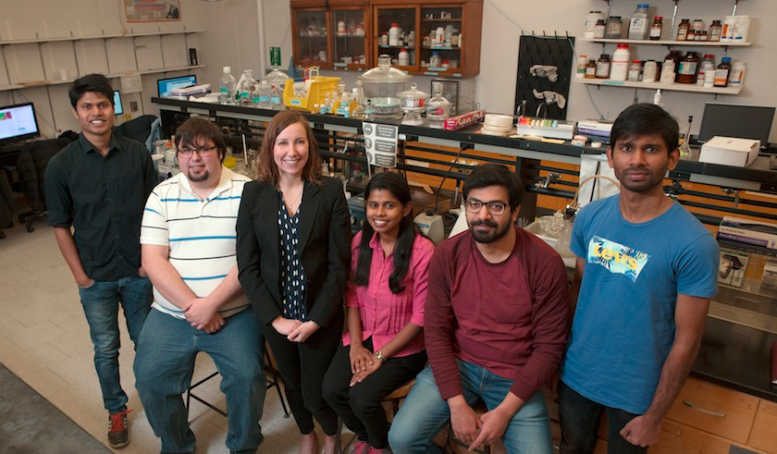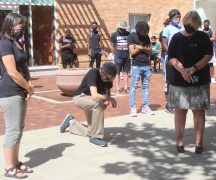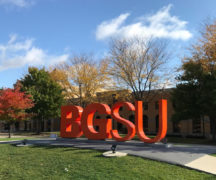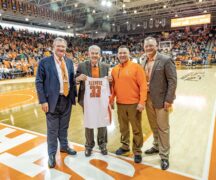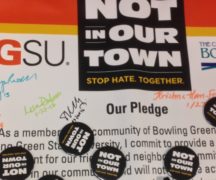By DAVID DUPONT
BG Independent News
The research agenda at Bowling Green University produces advances in knowledge while having benefits close to home. That was evident at the October Board of Trustees meeting when four recently hired faculty made presentations on their work.
In introducing them, Vice President for Research and Economic Engagement Michael Ogawa reported that external grant funding for research has had “a strong upward trajectory.” In the current fiscal year, BGSU has received 7 percent more than 2016, and 2016 had seen a 22-percent increase from the previous year.
These grants, he said, are highly competitive. Only 15 percent of applications are successful.
The four faculty members presenting – Alexis Ostrowski, chemistry, Julie Halo Wildschutte, biological sciences, Jonathan Bostic, teaching and learning, and Kimberly Rogers, mathematics and statistics – have all been successful in securing external funding.
Ostrowski said her research is connected with teaching as well as real world applications and entrepreneurship.
She noted that one graduate student Giuseppe Giammanco was a contestant in the 2016 Hatch program. He developed gel beads for use in consumer products to replace chemical ingredients that are now banned because of water quality concerns.
Ostrowski said the gel beads are made by combining iron with biopolymers from natural ingredients. One project has phosphate enclosed into the gel beads. These are put into the soil and slowly release their contents. These are being tested on kale plants. “We’ve got some exciting initial results.”
Working with Bob Midden, chemistry, they are investigating using the beads to pull the phosphate from animal waste. Once in the beads, she said, “the phosphates stay on the field longer and won’t wash away the nutrients after one rainfall.”
Phosphate rich runoff from farm fields is a major source of water pollution in Lake Erie.
All this work is done by both graduate and undergraduate students. She said her focus is on training graduate students so they can go on to get doctoral degrees and join the scientific ranks. Those graduate students are all involved in mentoring undergraduates who are engaged in summer research, independent study, or honors projects.
Undergraduates are also key participants in Wildschutte’s lab.
She is engaged is studying the interactions of retroviruses and their hosts and cross species infection, which is the way HIV moved into the human population.
She also studies mobile elements, small piece of genetic material that are able to copy themselves and move to other parts of the chromosomes causing mutations.
Wildschutte said there’s “an arms race” between viruses and hosts as each evolves. The virus evolves in ways to better infect the host, and the host evolves in ways to protect itself from the virus.
Both graduate and undergraduate students are involved in this work. Most of her undergraduates are planning to go on in medicine and medical research, she said, and all have earned authorship on scholarly papers. Some will have authorship on multiple publications before they graduate.
Wildschutte said she envisions the research attracting more funding and helping to recruit high quality students, like those now in her lab, to BGSU.
Bostic’s focus has been developing a test that measures problem solving that aligns with the Common Core educational standards.
“Problem solving is a key 21st century skill,” he said. “We know we need problem solvers. … If problem solving is part of day-to-day instruction then it stands to reason that students should be assessed on it.”
Most standardized tests either don’t measure, or are not aligned with the content being taught, or place an undue burden on teachers and students.
So Bostic set out to develop a test that was “valid, meaningful, and doesn’t cause an undue burden on students or teachers.”
That test, funded by a highly competitive National Science Foundation grant, has been administered thousands of times to establish its validity. The response has been that teachers and students found the test no more difficult to give and take than others.
“Some actually say they’ve learned from these tests,” Bostic said
He started with a test for grades 4 through 6, and now, working with schools in the area, is developing one for grades 3 through 5.
Graduate student Davis Gerber told the trustees that his own research has shown that the more ways students used to solve a problem, the more they learn.
Bostic said the university is working on commercializing the test. “It’s slow process. … We’re trying to move it to market so it’s broadly available.” He said a major publisher has expressed interest in working with him.
Rogers’ research also involves teaching. In her case it is helping graduate students who teach entry level undergraduate courses to be better instructors.
Many of these graduate students teach introductory statistics. That course has about 1,200 students in 40 sections. Often this is the only math course they take.
Rogers enlisted four graduate students who had taught these courses and had good student evaluations to work as peer mentors with new instructors in both small groups and individually.
The results, Rogers said, are encouraging. Students in the courses where the instructor had been mentored had better grades and fewer got Ds and Fs.
Jordan Bounds was one of the first class to be mentored, and is now a mentor. He spoke of working with one graduate student who would each with without notes. At best he had an outline. Bounds observed the class, and saw how ineffective that was. He was able to convince the instructor that he needed to have more thorough notes prepared so that he was making sure he was adequately presenting the course material.
“You don’t always know what it is you don’t know until you have someone tell you about it,” Bounds said.
Rogers said she’s pursuing funding to continue the program. “We’re trying to work out how we can help other universities do things like this.”

